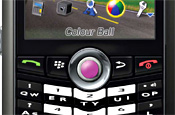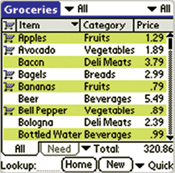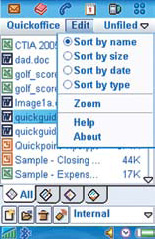
 |
Smartphones work pretty well as PDAs and some do double duty as satnavs, but the smartphone genre would never be so successful without the mass of third-party software applications that have been developed – indeed, we define a smartphone essentially as a phone on to which the user (or the user’s IT department) can add additional third-party software.
That’s because a smartphone runs a native operating system for which a
programmer can write software; and most smartphones can be programmed with standard programming languages and APIs, so even a moderately competent programmer should be able to produce something that works.
How well it works is an issue, of course. You’d think the inherent restrictions of the phone environment – limited screen real estate, limited options for input, limited processor power and memory, limited OS capability – would make it easier to knock up a working app. In fact they make it more difficult; or rather, they demand a special set of programming skills. It’s rather like the difference between a good grill cook and a good banquet chef; in both cases the resulting meal could be excellent (or rubbish) even though the environment in which you consume it will be very different.
That said, there are some excellent examples of good mobile phone software out there, and an active retail marketplace has developed alongside free or shareware. That’s because smartphones are getting into the mainstream in terms of shipments, approaching 12-15% of the worldwide mobile phone market according to analysts. We reckon there are four good reasons for this:
Increasing demand for 3G and mobilebroadband applications – especially mobile email, web search, instant messaging and mobile VoIP. This is synergistic; the more applications there are available for smartphones, the more interested the user is in using a smartphone. And once they have a smartphone, the more motivated they are to get the most out of it.
Falling prices and increasing variety – prices are dropping fast in response to increased sales volume. And the range of available models is growing rapidly
Improvements in capability – declining component cost means it’s becoming economic to include facilities like WiFi and A-GPS. And power consumption and battery life are both getting better, though there’s a long way to go yet (some smartphones are battery hogs, especially when using 3G or GPS).
The channel is getting better at promoting, demonstrating and actually selling smartphones. It’s no longer a knee-jerk B2B sell.;
Trends in software
Handango, the world’s top distributor of smartphone software, recently released its 2007 Year-end Handango Yardstick. Essentially this provides a worldwide snapshot of what’s selling well (and over 50% of Handango’s users come from outside the company’s US homeland, so the results do have international validity).
For the first time since Handango has been running the Yardstick, entertainment content was the leading sales category with 17% of the total (up from third place in 200). Business and professional content was the predictable leader in 2006 with 18% of content sales, but in 2007 it dropped to second place with 16%.
That obviously signals the arrival of the ‘prosumer’, the shift away from using smartphones primarily for business and productivity-related activities exemplified in devices like the BlackBerry Pearl, the Nokia E65, and Palm’s Centro.
Handango’s report confirms this – it shows that smartphones created and marketed to consumers to use for work and play were among the leading devices for content downloads in 2007. BlackBerry got most attention from developers. More than 11,000 new mobile applications for the BlackBerry were added to the Handango poprtfolio in 2007, and the BlackBerry collection grew faster than any other OS – 135% more applications were added in 2007 than in 2006.
Productivity applications (such as address book and calendar) and Games took at third and fourth place, respectively in the Handango list.
The Handango Yardstick is a global trend report about the smartphone content industry. It consolidates and reports on key smartphone market data based on content purchases on a quarterly and annual basis from across the Handango distribution network—the Handango. com website, partner storefronts including carriers, OEMs and operating system partners (which now include Carphone Warehouse), as well as individual application developers’ websites that are powered by the Handango Commerce Engine.
Market data in the report includes sales by content category; sales by device; top searches; the number of new software providers and applications added to the Handango library, and best-selling applications for each of the five major smartphone operating systems:
- BlackBerry
- Palm OS
- Symbian OS
- Windows Mobile Standard (formerly Smartphone)
- Windows Mobile Professional (formerly Pocket PC)
Download a copy of the 2007Year-end Handango Yardstick from http://corp.handango. com – go to the Press Room tab and click on ‘Yardstick’.
BlackBerry
Handango reported a stellar year for BlackBerry apps. Of course this operating system continues to be popular with consumers interested in Business & Professional content, as sales in that category topped 31% in 2007, while Entertainment content came in second at 23%.
The BlackBerry Pearl was the most popular device for mobile content in 2007, both in terms of revenue and units sold.
 |
| This Sudoku comes in various OS flavours but works very well on BlackBerry |
 |
| Ringtone Megaplex – change your ringtone. A best-seller |
 |
| SplashWallet combines four apps in one, but basically it’s a list manager, personal finance tracker and password memory |
 |
| Quickoffice File Manager, the starting point for the excellent Microsoft Office reader/ editing suite |
GetJar, a smartphone software source which runs more as a mobile application distribution and developer community, claims that it offers the broadest range of applications to mobile users – an average of over 8m downloads per month (and over 100m in the last two years). It brings developers and users together by offering a community where developers can beta-test their products for free, and where consumers can access the latest and best Java, Symbian, Windows Mobile and Palm applications in return for their feedback.
GetJar has awarded its annual Mobile Application of the Year Award to the Opera Mini web browser. The award comes as a result of consistently high user ratings and good feedback; Opera Mini was the most downloaded application from the GetJar portfolio last year, with over 3.3m downloads.
It has all the features expected of a browser, such as content download, skinning, bookmarks, browsing history. It’s fast (thanks to clever compression on the internet traffic) and completely secure (so webmail is safe).
And best of all, it’s still free…
Tatsuki Tomita, Head of Consumer Products at Opera, regards the GetJar award as “ incredibly valuable recognition for Opera, from what is the biggest and most influential mobile application user community in the world ... The insight of GetJar users has assisted us in shaping the product so it better meets their needs. It has also allowed us to develop a product that runs well on all the world’s 800+ million Java-enabled phones.”
In addition, GetJar has also presented awards to RDM+ for Best Enterprise Application, to Vikrant Chavan’s Dictionary for Best Consumer Application, and to Army Vs Crime for Best Game. GetJar also recognised Nav4all with an award for Up and Coming product.
- RDM+ Remote Desktop for Mobiles: RDM+ allows you to access your computer from mobile device remotely. You can send and receive emails, surf web, edit documents, copy, cut, paste files or folders and do hundreds other things that you typically do sitting in front of a desktop.
- Dictionary: An easy-to-use English dictionary that is compatible with all J2ME devices, needs only 1MB memory, and is completely free.
- Army vs. Crime: You are the commander of elite fighting unit which combats terrorism and crime through 60 missions around the globe. So that’s a good thing then. The short search-and-destroy action means you can save the world between trains…
- Nav4All: Free satnav from your own mobile phone, with permanent access to the most up-to-date routes and maps on the Nav4All server. Clear arrows on your screen and spoken voice-instructions will guide you to your destination – worldwide. Very impressive.
